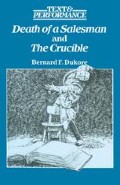Abstract
Miller describes the private rooms that are the settings of the first two acts as furnished in a spartan manner beneath exposed roof rafters. A bed is the major furnishing of the first, establishing illness (that will spread); a pot hanging above a fire and a table set for dining the second, establishing a family (that will be imperilled). The public rooms of the last two acts similarly contrast with each other. The first, used by the court, has three doors, suggesting the possibility of exit as well as entry; the second, a prison cell, has only one ‘great, heavy door’, whose connotations are clear cut.
Copyright information
© 1989 Bernard F. Dukore
About this chapter
Cite this chapter
Dukore, B.F. (1989). Scenery and Lighting. In: Death of a Salesman and The Crucible. Text and Performance. Palgrave, London. https://doi.org/10.1007/978-1-349-08599-6_19
Download citation
DOI: https://doi.org/10.1007/978-1-349-08599-6_19
Publisher Name: Palgrave, London
Print ISBN: 978-1-349-08601-6
Online ISBN: 978-1-349-08599-6
eBook Packages: Palgrave Literature & Performing Arts CollectionLiterature, Cultural and Media Studies (R0)

